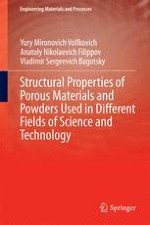This book provides a comprehensive and concise description of most important aspects of experimental and theoretical investigations of porous materials and powders, with the use and application of these materials in different fields of science, technology, national economy and environment. It allows the reader to understand the basic regularities of heat and mass transfer and adsorption occurring in qualitatively different porous materials and products, and allows the reader to optimize the functional properties of porous and powdered products and materials. Written in an straightforward and transparent manner, this book is accessible to both experts and those without specialist knowledge, and it is further elucidated by drawings, schemes and photographs.
Porous materials and powders with different pore sizes are used in many areas of industry, geology, agriculture and science. These areas include (i) a variety of devices and supplies; (ii) thermal insulation and building materials; (iii) oil-bearing geological, gas-bearing and water-bearing rocks; and (iv) biological objects. Structural Properties of Porous Materials and Powders Used in Different Fields of Science and Technology is intended for a wide-ranging audience specializing in different fields of science and engineering including engineers, geologists, geophysicists, oil and gas producers, agronomists, physiologists, pharmacists, researchers, teachers and students.
